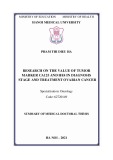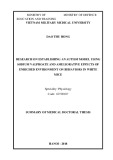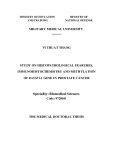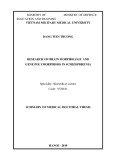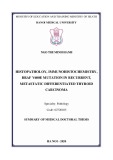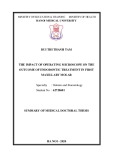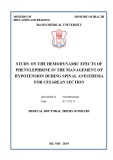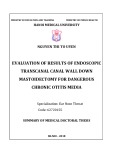THE MINISTRY OF THE MINISTRY OF
EDUCATION AND DEFENSE
TRAINING
MEDICAL MILITARY UNIVERSITY
LONG HUYNH THANH
A STUDY OF THE LYMPH NODE METASTASIS AND THE
EFFECTIVENESS OF LAPAROSCOPIC RADICAL SURGERY
FOR COLON CANCER
Speciality: General surgery
Code: 62 72 01 25
ABSTRACT OF MEDICAL DOCTORAL THESIS
HA NOI – 2018
THE THESIS WAS COMPLETED AT
MEDICAL MILITARY UNIVERSITY
The scientific instructors:
1. Assoc. Prof. Ph.D. NUNG HUY VU
2. Assoc. Prof. Ph.D. BAC HOANG NGUYEN
Reviewer 1: Prof. Ph.D. THINH CUONG NGUYEN
Reviewer 2: Assoc. Prof. Ph.D. DUNG TUAN TRINH
Reviewer 3: Assoc. Prof. Ph.D. DUNG VIET DANG
The thesis will be judged by the board of examiners of Medical
Military University
At: ………… o’clock, … / … / 2018.
The thesis can be found at:
- National Library of Vietnam
- Medical Military University’s Library
1
INTRODUCTION
Colon cancer is a common malignant disease, second to the stomach
cancer among gastrointestinal cancers. One of the main milestones in the
treatment of colon cancer is the multimodal therapy approach, and radical
surgery remains the only potentially curative therapy for patients.
Lymph nodes are the primary metastatic pathways of cancer cells,
thereby the goal of radical surgery for colon cancer is complete removal of a
tumor and harvest lymph nodes. Determining the correct number of lymph
nodes and the number of local metastatic lymph nodes is essential in the
precise diagnosis of the disease stage, which is the groundwork for deciding
which postoperative supportive therapies should be administered.
Laparoscopic radical surgery with D3 lymph node dissection forcolon
cancer, in our opinion,is the necessity for any surgeon. Recently, most classic
surgical techniques have been replaced by laparoscopic surgery in Vietnam as
well as in the world. It is true that there have been numerous articles on this
subject. Notwithstanding, they were still fragmentary, not generalized enough
and had not correctly identified the lymph node metastasis and the results of
radical surgery, especially the correlation of laparoscopic surgery in this area.
As the results, we would like to pursue the thesis: “A study of the lymph
node metastasis and the effectiveness of laparoscopic radical surgery for colon
cancer”. The thesis has two objectives:
1. Determining the degree of lymph node metastasis and
characteristics of lymph node dissection technique in laparoscopic
surgery for colon cancer.
2. Evaluating the effectiveness of laparoscopic radical surgery for
colon cancer and their related factors.
NEW CONTRIBUTIONS OF THE THESIS
Colon cancer is a common malignant disease, second to the stomach
cancer among gastrointestinal cancers.
2
One of the main milestones in the treatment of colon cancer is the
multimodal therapy approach, and radical surgery remains the only potentially
curative therapy for patients. There have been numerous articles on
laparoscopic surgery for colon cancer; nonetheless, not many of them
mentioned lymph node harvesting on laparoscopic radical surgery.
The scientific contributions of the thesis:
Laparoscopic radical colectomy with D3 lymph node dissection should
be indicated before colon cancer has not invaded the organs and has not
metastasized.
The lymph node dissection technique includes four steps and need to
use 3-4 trocars. In the first and second steps of the procedure, mesenteric
release and vascular control technique should perform mesenteric lift from the
center to the periphery, clamp blood vessels carefully before mesenteric
release. The results of restoring intestinal continuity using hand or machine
stitches are similar.
The average time of operation is 136,5 ± 33,9 minutes. We have
harvested 1800 nodes, an average of 17.34 ± 4.25 nodes. The average
postoperative length of stay is 7.45 days. The average postoperative follow-up
duration is 29.67 months and is associated with stage of disease, lymph
metastasis, degree of invasion, proportion of metastatic lymph nodes on the
total number of harvested nodes, histopathological types, and postoperative
chemotherapy. There was no association between age, genders and
postoperative survival time.
The prevalence of local recurrent colorectal cancer is 8.7%, distant
metastasis 9.7%, complications 0.97%. There were no cases of recurrent colon
cancer at the trocar or at the small incision for biopsy. There was no death
record.
THE STRUCTURE OF THE THESIS
The thesis has 135 pages, including; introduction: 2 pages, chapter 1.
Overview: 40 pages, chapter 2. Objects and research methods: 20 pages,
3
chapter 3. Results: 36 pages, chapter 4. Discussion: 34 pages, Conclusion: 2
page and Recommendation: 1 pages.
CHAPTER 1. OVERVIEW
1.1. Colon Anatomy
Colon separation:
+The right colon consists of the cecum, ascending colon, hepatic
flexure, and the immovable part of the transverse colon.
+ The left colon consists of the two third movable part of the transverse
colon, splenic flexure, descending colon and the sigmoid colon.
1.2. Vascular anatomy of the colon
1.2.1. Vascular anatomy of the right colon
The right colon is nourished by the superior mesenteric artery. The
superior mesenteric artery arises from the anterior surface of the abdominal
aorta. The superior mesenteric artery gives many lateral branches, including
inferior pancreaticoduodenal artery, intestinal arteries, ileocolic artery, right
colic artery and middle colic artery.
1.2.2.Vascular anatomy of the left colon
Blood supply to the left colon is the inferior mesenteric artery. The
length of inferiormesenteric artery is 42 mm, with an average diameter of 3.3
mm, most likely from a 5 cm upper abdominal aorta where the aorta split in
two, below the mesentery artery, the renal artery and genital arteries. The
majority of authors believe that the inferior mesenteric artery arises at the level
of L3 vertebra.
1.2.3. The lymphatic system of the colon
The lymphatics of the colon are divided into 3 groups: group 1 lymph
nodes are inside the colon wall and outside the colon, group 2 located along
the, group 3 - the main lymph nodes located around the root of the lower
mesenteric artery.
1.3. Pathology of colorectal cancer
1.3.1. Macroscopic classification: exophytic, ulcerated, infiltrating types…
4
1.3.2. Microscopic classification: adenocarcinoma (90-95%) and divided into
three categories: high, moderate, and low grade differentiation forms (poor
prognosis). Besides, there are some rare types such as lymphoma, sarcoma,
squamous cell carcinoma, bright cells…
1.4. Stages-classification by TNM system
The TNM system arranges the stage of colon cancer based on three
factors: the invasive depth of a primary tumour, the number of metastatic and
metastatic lymph nodes. TNM staging chart in the following colorectal cancer:
T (tumor): primary tumor.
Tx: primary tumor cannot be assessed.
T0: no evidence of primary tumor.
Tis: carcinoma in situ, intramucosal carcinoma.
T1: tumor invades submucosa (through the muscularis mucosa but not
into the muscularis propria).
T2: tumor invades muscularis propria.
T3: tumor invades through the muscularis propria into the pericolorectal
tissues.
T4a: tumor invades through the visceral peritoneum (including gross
perforation of the bowel through tumor and continuous invasion of tumor
through areas of inflammation to the surface of the visceral peritoneum).
T4b: tumor directly invades or adheres to other adjacent organs or
structures.
N (node): Regional lymph nodes metastasis.
Nx: regional lymph nodes cannot be assessed.
N0: no regional lymph node metastasis.
N1: metastasis in 1 - 3 regional lymph nodes.
N1a: metastasis in 1 regional lymph node.
N1b: metastasis in 2 - 3 regional lymph nodes.
N1c: no regional lymph nodes are positive but there are tumor deposits
in the subserosa, mesentery or nonperitonealized pericolic or perirectal /
5
mesorectal tissues.
N2: metastasis in 4 or more regional lymph nodes.
N2a: metastasis in 4 - 6 regional lymph nodes.
N2b: metastasis in 7 or more regional lymph nodes.
M (metastasis): distant metastasis.
Mx: unable to identify distant metastasis.
M0: no distant metastasis by imaging; no evidence of tumor in other
sites or organs.
M1: distant metastasis.
M1a: metastasis confined to 1 organ or site without peritoneal
metastasis.
M1b: metastasis to 2 or more sites or organs is identified without
peritoneal metastasis.
Table 1. Table of stages according to TNM
Stages T N M
0 Tis N0 M0
I T1, T2 N0 M0
IIa T3 N0 M0
IIb T4a N0 M0
IIc T4b N0 M0
IIIa T1, T2 N1 M0
T1 N2a M0
IIIb T3, T4a N1 M0
T2, T3 N2a M0
T1, T2 N2b M0
IIIc T3, T4 N2 M0
IVa any T any N M1a
IVb any T any N M1b
1.5. Lymph node dissection for colon cancer
Lymph node dissection in colon cancer treatment is also based on
6
independent lymphatic transmission and is named: D0, D1, D2, and D3.
Currently, there is no concept of D4 lymph node dissection, because D4 lymph
node metastasis is considered to have distant metastatic, so the results of
surgery is less effective.
1.6. Laparoscopic surgery for colon cancer
1.6.1. Principles of radical surgery for colon cancer
Standard colon resection: ensuring a safe cut according to anatomic
location of the tumor. Upper colon section cut at least 10cm minimum upper
margins of a tumor, cut at least 5cm below a tumor. Regional lymph node
dissection is the removal of all nodes along the blood vessels that feed the
resected colon, and the suspected metastatic lymph nodes, removing all
invasive and metastatic organizations. The minimum number of lymph nodes
need to be examined is 12 nodes.
1.6.2. History of laparoscopic colectomy
In 1990, Jacobs performed a right hemicolectomy, the anastomosis was
done outside the body through a 5 cm incision.
In 1990, Lahey performed a rectosigmoid colon resection; the
anastomosis was done by a ring hand-sewing and stapling machine.
In 2008, Bucher performed a single-port access laparoscopic colectomy.
In 2015, Nguyen Huu Thinh performed a single-port access
laparoscopic colectomy at the Medical and Pharmaceutical University
Hospital.
Recently, many domestic hospitals have routinely performed
laparoscopic surgery for colon disease.
1.6.3. A review of the researches on lymph node dissection for colon cancer
in Vietnam
In 2002, Nguyen Vang Viet Hao studied lymph node metastasisin colon
cancer on biopsy specimens collected in laparotomy using conventional
histological examinations.
In 2002, Le Huy Hoa studied clinical and pathological characteristics of
7
lymph node metastasis in colon cancer.
In 2010, Nguyen Trieu Vu studied nodal metastasis in colorectal cancer.
In 2010, Nguyen Thanh Tam studied lymph node lesions in colorectal
adenocarcinoma.
In 2011, Nguyen Cuong Thinh studied the characteristics of nodal
metastasis in colorectal cancer.
1.7. Chemotherapy
The treatment of colon cancer is the multimodal therapy; chemotherapy
therapy is required at the post-operation stage.
CHAPTER 2. MATERIALS AND RESEACH METHODS
2.1. Study Population
The study was conducted with patients who admitted to Nguyen Tri
Phương hospital from 11/2011 to 12/2015 with diagnosed of primary colon
carcinoma.
2.1.1. The criteria for selecting patients
Patients recruited in the study must meet the following criteria:
- Diagnosed of primary colon carcinoma by histopathological
examination after surgery.
- Performed laparoscopic radical colectomy with D3 lymph node
dissection at Nguyen Tri Phuong hospital.
- Complete medical records and postoperative information.
2.1.2. Exclusion criteria
- Intestinal obstruction.
- Conversion to open surgery.
- Distant metastasis (M1) before surgery.
- Severe comorbidities with ASA IV
2.2. Methods
2.2.1. Study design
An uncontrolled prospective study, cross-sectional description,
8
vertical monitoring.
2.2.2. Sample size determination: Minimum sample size is calculated based
on the formula for cross sectional study: N = Z2
(1-α/2) P (1-P)/d2
Where: Z2
(1-α/2): confidence interval. Z (1-α/2) for 95% confidence level = Z (0.975)
= 1.96.
P: estimated proportion. p is the prevalence of local recurrent colon
cancer = 0.95.
d: desired precision, d = 5% N: sample size, N = (1.96)2 × 0.05×0.95 / 0.052 = 73 . The minimum of sample size should be 73.
2.2.3. Indications for laparoscopic radical surgery with D3 lymph node
dissection for colon cancer
* Study diagram
Colon Adenocarcinoma
Inability to perform radical surgery
Ability to perform radical surgery
Laparoscopic evaluation
Excluded from study
Step 1: Release the mesentery Step 2: Control blood vessels Step 2: Vascular control technique
Evaluate
Tumors
-
-
Lymph nodes
Step 3: Harvest D3 lymph node and dissect mesentery
-
Histopathology
Step 4: Make a small incision forbiopsy and restore intestinalcontinuity
-
Stages classification
End of surgery
Follow-up re-examination
Hospital discharge
9
* Indications for laparoscopic right radical hemicolectomy for colon
cancer treatment: is a procedure that involves removing the right first half of
the transverse colon, the hepatic flexure (where the ascending colon joins the
transverse colon), the ascending colon, the cecum and 15-20cm of the terminal
ileum, along with ileocolic artery, right colic artery and middle colic artery,
mesentery and metastatic node group 1, 2, 3.
* Indications for laparoscopic left radical hemicolectomy for colon
cancer treatment: is the surgical removal of the left second half of the
transverse colon, the splenic flexure (where the descending colon joins the
transverse colon), descending colon, sigmoid colon, inferior mesenteric artery,
middle colic artery, mesentery and metastatic node group 1, 2, 3.
2.2.4. Research vairables
- The general characteristics of subjects: age, gender, medical history,
ASA.
- Sub - clinical indicators: CEA, colonoscopy, histopathology.
- Surgical procedure:
Surgical procedure characteristics: surgical method; time of operation;
blood loss volume; time to pass gas; tumor: macroscopic features, size, degree
of invasion; node: number, size, density, group; complications; length of
hospital stay, mortality.
Factor related to lymph node metastasis: tumor location, age, gender,
differentiation of cancer cells, degree of invasion, macroscopic features, size of
lymph node, density and group of lymph node metastasis.
Surgical techniques: Mesenteric release technique, vascular control
technique, lymph node dissection, restore intestinal continuity.
- Long-term results after surgery: increased postoperative CEA level,
quality of life after surgery, recurrence, metastasis; factors related to recurrent
metastasis: tumor location, size, the differentiation of cancer cells, degree of
10
invasion, TNM, stages of cancer, increased postoperative CEA level, stage of
disease, post-operation chemotherapy.
2.2.5. Data analysis method
- Data were collected according to chosen medical records, stored and
statistically analyzed using SPSS 18.0 software
- The quantitative variables are described by mean and standard
deviation.
- The qualitative and categorical variables are described by percentage,
Chi-quare test is used to test for the significant difference.
- The results are displayed on tables, charts, images.
- Postoperative survival time and associated factors were calculated
using the Kaplan-Meier algorithm.
CHAPTER 3. RESULTS
3.1. The general characteristics of subjects
3.1.1. The characteristic of age, gender, medical history and ASA of subjects
- Age: the youngest patient is 18 years old; the oldest patient is 85 years
old, average age is 59.61 ± 14.4.
- Gender: 56 males (54.5%), 47 females (45.6%), male-to-female sex
ratio is 1.19:1
- Medical history: 36 cases with associated medical disease accounted
for 36%.
- ASA: I 1 (1.9%), II 89 (86.4%), III 12 (11.7%).
3.1.2. Laboratory tests
- Preoperative CEA levels: minimum 0.8ng/ml, maximum 333.7ng/ml;
mean 18.09 ± 46.3ng/ml.
- Colonoscopy results: right colon cancer 33 (32%), left colon cancer 70
(68%). Macroscopic features: protruding type 74 (71.9%), ulcerated type 6
(5.8%), ring type (9.7%), polyp 13 (12.6%).
11
3.2. Research results of lymph node metastases and some technical
specifications
3.2.1. Research results of lymph node metastasis
3.2.1.1.Lymph nodes characteristics
We have harvested 1800 nodes, including 198 nodal metastasis, the
lowest node size is 0.5 cm, the largest node size 3.5 cm: the average node size
1.0408 ± 0.7cm, 52 hard lymph nodes (50.5%), The rate of metastatic node
group 1, 2, 3 in our study were 22.3%, 19.4%, and 7.8% respectively. N0, N1,
N2 stages were 50.5%, 27.1%, 22.4%. Right colon nodal metastasis 45.5%,
left colon nodal metastasis 51.4%.
3.2.1.2. Tumor characteristics
- Size: maximum size 10cm, minimum size 1cm, mean size 4cm
- Macroscopic type: protruding type 67 (65%), ring type 26 (25.2%),
others 10 (9.7%).
- Tumor Differentiation: high-grade 10 (9.7%), mediate-grade 75
(72.8%), low-grade 18 (17.5%)
- Tumor invasion: T1, T2, T3, T4 were 7.8%, 45.6%, 31.1%, 15% with
respectively metastatic prevalence 25%, 31.9%, 68.8%, 75%.
3.2.2. Lymph node metastasis related factors
* Tumor location: 15 cases of right colon cancer (45.5%), 36 cases of
left colon cancer (51.4%). Age and gender were not associated with lymph
node metastasis. Tumor differentiation: high-grade 0 (0%), mediate grade 34
(45.3%), low grade 17 (94.4%). T1: 2 (25%), T2: 19 (40,4%), T3: 17 (53.1%),
T4: 13 (81.2%). Hard density 50 (98%), soft density 1 (2%). Number of nodes
which size ≤ 0.5cm is 52, node metastases are 14 (26.9%), number of nodes
which size > 0.5cm is 51, node metastases are 37 (72.5%). TNM tumour
stages 1, 2, 3, 4 are accounted for 25%, 22.2%, 97.8%, and 100%,
respectively. The prevalence of nodal metastases in the total removed nodes:
total harvested nodes are 1800 nodes, nodal metastases are 198 nodes, the
prevalence is 0.11. Numbers of high preoperative CEA level are 58 inculding
12
32 node metastases (55.2%), numbers of low preoperative CEA level are 45
inculding 19 node metastases (42.2%).
3.2.3. Characteristics of lymph node dissection technique in laparoscopic
surgery
3.2.3.1. Patient's position and position of the surgeon in laparoscopic surgery
The author suspected that the patient's position and position of the
surgeon would not affect the results of the operation. The author had instructed all patients to lie flat on the operating table, raise both legs to create an 45o different angle to the operating table. The patient then is instructed to incline to
the right when performing nodal dissection in the left colon and vice versa.
The surgeon and the cameraman stand side by side at the end of the
operating table; the second assistant and equipment assistant stand the both
sides of the operating table.
3.2.3.2. Number of trocar: 3, 4, 5. There was one case which used 5 trocars.
3.2.3.3. Main steps:
Mesenteric release technique (mesenteric lift): Step 1: there were 7 cases
which had to perform mesenteric lift from the outside in (6.8%), 96 cases
performed mesenteric lift from the inside out (93.2%). Step 2: 96 cases of
clamping blood vessels before tissue separation (93.2%), 7 cases of clamping
blood vessels after tissue separation (6.8%). Step 3: 1 complication (0.97%).
Step 4: Restore intestinal continuity technique: there are 3 cases of machine
stitches (2.9%) and 100 cases of hand stitches (97.1%).
3.2.3.4. Operating time: right colon dissection took 70 minutes; left colon
dissection took 100 minutes
3.2.3.5. Blood loss: right colon resection bled 73 ml; left colon resection bled
66 ml
3.2.3.6. Complications: right colon 0%, left colon 0.97%.
3.3. Reseach results of lymph node dissection technique in laparoscopic
surgery and related factors
3.3.1. Short-term results
13
- On average, our surgery took 136.5 ±33.9 minutes; the fastest surgery
took 80 minutes; the most extensive surgery took 220 minutes. Time to
postoperative pass gas: 1.5±0.6 days. Time to postoperative oral nutritional
supplementation: 2.5±1 days. Blood loss: 68.5 ml on average. Complication:
one case where the left urethral had to be cut out, which accounted for 0,97%.
Postoperative complications: 10 cases (9.7%) including 8 cases of wound
infection (7.8%), one case of bowel obstruction after left colon dissection
(0,97%), one case of pneumonia (0.97%). Length of hospital stay: the least
were 4 days, the longest were 16 days, on average were 7.45 days.
3.3.2. Long-term results
- The shortest postoperative supervision period we provided was 11
months; the longest was 58 months, 8 fatality cases (8%), 95 surviving cases
(92%). Postoperative CEA levels increased: 10 cases (9.7%). Postoperative
chemotherapy: 83 patients underwent chemotherapy (80.6%), 20 patients did
not undergo chemotherapy
(19.4%). Survival rates of our
patients at the 36th month were
91.35%. Postoperative survival
with and without lymph node
metastases were 86.8% and
96.1%, respectively.
Figure 3.1. Cum
Follow-up duration (months)
postoperative survival odds
- Local recurrence: 8.7%. Distant metastasis: 9.7%.
- The prevalence between nodal metastases and total harvested nodes:
11%.
- Related factors to local recurrence and distant metastasis.
Follow-up duration (months)
* Tumor size: the difference between local recurrence and distant
metastasis with the tumor size were statistically signification (p<0.001 and
p=0.046, respectively). * Invasiveness: the difference between local recurrence
14
and distant metastasis with the tumor invasiveness were statistically
Follow-up duration (months)
signification (p<0.001 and p=0.002, respectively). * Nodal metastases: the
difference between local recurrence and distant metastasis with nodal
metastases were statistically signification (p=0.002 and p=0.001, respectively).
* TNM system stages: the difference between local recurrence and distant
metastasis with TNM system stages were statistically signification (p= 0.021
and p<0.001, respectively). * Differentiation: the difference between local
recurrence and distant metastasis with the differentiation were statistically
signification (p<0.001 and p<0.001, respectively). * Stages T: the difference
between local recurrence and distant metastasis with the Stages T were
statistically signification (p<0.001 and
p=0.012,
Chemotherapy Yes No Postoperative survival time with chemotherapy Postoperative survival time without chemotherapy
respectively).
* Increased
postoperative CEA level: there were 4
cases of local recurrence and distant
metastasis (30.8%).* Postoperative
chemotherapy * Postoperative survival
with and without chemotherapy were
Follow-up duration (months)
97.2% and 62.2%, respectively.
Figure 3.2. Cum postoperative survival with chemotherapy odds
Chapter 4. DISCUSSION
4.1. Characteristics of research samples
4.1.1. Age, genders, date of birth, ASA
* Age: the average age of patients is 59.61 ± 14.4, the youngest is 18
years old, the oldest 85 years old. According to the study of Nguyen Hoang
Bac, which the average age was 51-63 years. In Luu Long Phung's study, the
average age was 59.2 ± 15.9; the youngest patient was 29 years old, the oldest
patient was 85 years old. The majority of the study belongs to the 40+ age
15
group, which are accounted for 87.5% (28/32 cases).
* Genders: Our research samples have the male / female ratio of 1.19 /
1. Nguyen Hoang Bac's study has the ratio of 1.7 (64% male and 36% female).
Nguyen Thanh Tam's study has the ratio of 1.47, Nguyen Cuong Thinh's study
has the ratio of 1.47, and Sinkeet S is 0.9.
* Medical History: chronic comorbid conditions, compared to Jayne D.
G.'s study, ours has less since we had a choice of diseases to reduce the risk of
complications during and after surgery in our study.
* ASA: Nguyen Ngoc Khoa had proposed to use ASA as a rating scale
to evaluate the risk of surgery. Our ASA II is accounting for 86.4%, the ASA
III accounted for 11.7%, similar to the COST's study of 14.3%. We found that
patients with ASA III after laparoscopic surgery had longer recovery time than
patients with ASA II. Therefore, in the study, patients were selected and
prepared to reduce complications during and after surgery.
4.1.2. Laboratory tests
Results of colonoscopy: 103 cases were examined by colonoscopy
which accurately determined the tumor position, macroscopy features and
helped the surgeon easily orient and handle the tumor.
Increased preoperative CEA level: 58 cases were positive, but only 32
of these cases had lymph node metastases. According to Andreas M. K and Vo
Van Hien, the preoperative CEA levels were statistically significant with
metastases nodes, p = 0.192. Although CEA concentration has a low
sensitivity in the diagnosis of colon cancer, the sensitivity would gradually
increase over the course of disease progression; hence, CEA is considered a
valid evaluation in the colon cancer diagnosis.
4.2. Characteristics of lymph node metastasis and lymph node dissection
technique
4.2.1. Characteristics of lymph node metastasis
4.2.1.1. Lymph nodes characteristics
* Quantity: We have harvested 1800 nodes, an average of 17.34 ± 4.3
16
nodes, less than Kim Y. W. is 22.3 nodes.
* Nodal density: 52 patients with hard nodes (50.5%), 51 patients with
soft nodes (51%). Like some other authors, hard nodes have a very high rate of
metastasis. Bori R. has a 6% of soft nodes for metastasis.
* Nodal size: according to Baxter N. N's study, most of the removed
nodes had ≥ 10mm in size, while in Cserni G. the majority of nodes were
≤5mm in size.
* Nodal metastatic groups: The rate of metastasis nodes were 22.3%,
19.4%, 7.8%. Our results are similar to Cserni G. and Choi P. W's results:as
close to the tumor, the number of lymph nodes as well as the number of
metastatic nodes is higher.
* Nodal metastasis according to TMN classification: The rate of
metastatic node group 1, group 2, group 3 in our study were 22.3%, 19.4%,
and 7.8% respectively. The results were similar to Adachy Y. which were
32.3%, 22.4%, and 8.6%. Nguyen Thanh Tam's results were 55.4%, 29.1%,
and 15.5%.
4.2.1.2. Tumor characteristics
* Size: Our average size of tumors was 4cm, which accounted for 39%;
Ceelen W's study was 4.1cm, and Luu Long Phung's study was larger than
4cm, which accounted for 43.8% (14/32 cases). During surgery, we concluded
that tumor size did not affect surgery manipulation. According to some other
studies, we also found no association between tumor size and lymph nodes
metastasis, with p = 0.046.
* Differentiation: the moderate-grade differentiated forms were
accounted for 72.8%, the high-grade differentiated forms' probability was the
lowest. Our results are the same as Kaiser A's. M and Kim J. The prevalence
of lymph nodes metastasis in patients with low-grade differentiated carcinoma
was the highest, which differ significantly from p <0.001. According to
Nguyen Thanh Tam, Nguyen Trieu Vu and Kim J., the prevalence of lymph
nodes metastasis in patients with high-grade differentiated carcinoma was the
17
lowest.
* Invasion: Our study concluded that the prevalence of metastatic node
metastases in T1, T2, T3, T4 stage were 25%, 31.9%, 68.8% and 75%,
respectively. The results are similar to that of Choi P. and Nguyen Thanh Tam.
The prevalence of metastatic node metastases increases with invasive levels of
tumor, which differ significantly from p <0.045. The higher the invasion
degree means higher the risk of metastasis.
4.2.1.3. Lymph node metastasis related factors
* Tumor locationand nodal metastases: our results showed that 45.5%
of right colon cancer metastasized and 51.4% of the left colon cancer
metastasized. The difference was statistically significant (p <0.015). Our
study, along with Nguyen Thanh Tam and Goldstein N. S., has shown the
difference in nodal metastases between the right colon and left colon cancer.
* Ages, genders and nodal metastases: the results from male and
female were almost similar; hence the difference was not statistically
significant (p = 0.914). The study also showed that the difference between
ages and node metastases was not statistically significant (p = 0.403).
* Differentiation and nodal metastasis: Our study results are in
agreement with Ricciardi R. and Min B. S. which the difference between the
differentiations of cancer cells with lymph node metastases was statistically
significant.
* T stages and nodal metastases: the prevalence of metastatic node
metastases in T1, T2, T3, and T4 stage were 25%, 40.4%, 53.1%, and 81.2%,
respectively. According to Valther R., the results were 15.6%, 18%, 69%, and
75%. Nancy's results were 22%, 38%, 77%, and 82%. The prevalence of
metastatic node metastases increases with invasive levels of tumor. According
to Cserni G., the difference between invasive degree and nodal metastasis was
statistically significant (p <0.005).
* Nodal density and nodal metastasis: Nodes with hard density are
statistically higher at metastatic rates than nodes with soft density. The
18
difference between nodal density and nodal metastasis was statistically
significant (p <0.001), which is consistent with Bori R. and Choi P’s results.
* Nodal size and nodal metastasis: the study results seem to suggest
that the larger the nodal size, the higher the nodal metastasis rate. However,
Nguyen Thanh Tam and one other author had concluded that nodal size only
poses as a reference value since nodal metastases still occur in nodes which are
less than 5 mm.
* N stages and nodal metastases: the prevalence of nodal metastases at
N1 and N2 were 27.1% and 22.4%. The results from Nguyen Thanh Tam's
study were 26.9% and 22.5%, respectively. The Meguid R. A.'s study also
provided equivalent results. The difference between nodal metastases and the
TNM tumour stages was statistically significant (p <0.001).
The prevalence of nodal metastases in the total removed nodes was
11%, similar to Nguyen Thanh Tam. When compared the results with other
authors, our results are not as high as Cserni G. (15.6%), Kim Y. (19.6%), and
Tsikitis VL (21.4%). It is undeniable that we need to perform nodal dissections
extensively and systematically, with a more careful manner.
* Preoperative CEA level and nodal metastases: the difference
between them was statistically significantly (p = 0.192). According to Nguyen
Thanh Tam, patients with high CEA level had the significantly higher rate of
nodal metastasis.
*The prevalence of nodal metastases in the total removed nodes from
our study was 11%, similar to Nguyen Thanh Tam’s study. When compared
the results with other authors, our results are not as high as Cserni G. (15.6%),
Kim Y. (19.6%), and Tsikitis V. L. (21.4%), which are likely to misestimate
the disease stages. It is undeniable that we need to perform nodal dissections
extensively and systematically, with a more careful manner.
4.2.2. Characteristics of lymph node dissection technique in laparoscopic
surgery
- Patient's position and position of the surgeon: In our study did not
19
follow the same procedure as other authors; however, we did not encounter
any difficulty during operation.
- Step 1: Mesenteric release technique (mesenteric lift): there were 7
cases which had to perform mesenteric lift from the outside in (6.8%), due to
large and sticky tumors, 96 cases performed mesenteric lift from the inside out
(93.2%).
- Step 2: 7 cases of clamping blood vessels after tissue separation
(6.8%). We found that without clamping blood vessels before tissue
separation, the results would result in excessive bleeding, and complications.
- Step 3: Nodal dissection technique: when performing nodal dissection
in the right colon, the surgeon must pay attention to avoid damage to the
duodenum, pancreas, and ureters. When performing nodal dissection in the left
colon, the surgeon should be cautious to avoid damage to the stomach, spleen,
pancreas, ureters, and genital arteries. There has been one case of surgical
complication; the left ureter was injured during rectosigmoid colon dissection
because the sigmoid colon tumor was large and sticky. Results: 579 nodes
were removed from the right colon dissections, 221 nodes from the left colon
dissections, N1 consisted of 986 nodes, N2 consisted of 493 nodes, and N3
consisted of 321 nodes. We found that nodal dissections by laparoscopic
surgery in the left colon were significantly more difficult than in the right
colon due to the more extended anatomical structure, deeper than the right
colon, many adjacent organs, easy to break the spleen if ones were not familiar
with taking down of the splenic flexure.
- Step 4: Restore intestinal continuity technique: there are 3 cases of
machine stitches (2.9%) and 100 cases of hand stitches (97.1%). As in the
study of Nguyen Hoang Bac has shown, no cases of anastomotic leakage, the
results were the same between using hand or machine stitches. However, using
machine stitches would result in shortening surgery time, but patients would
had to compromise the additional costs of the machine. As the results, we
agreed with many other authors that nodal dissection in the left colon requires
20
longer time and more effort.
4.3. Surgical results and related factors
4.3.1. Short-term results
4.3.1.1. Time of operation
On average, our surgery took 136.5 minutes; the fastest surgery took 80
minutes; the most extensive surgery took 220 minutes. On average, Nguyen
Hoang Bac's record was 155 minutes; surgery time could be shortened due to
surgeons' experience. Time to postoperative oral nutritional supplementation
was 1.5 to 2.5 days. Vo Thi My Ngoc's record was two days. Time to
postoperative pass gas was 1.5 days (1-3 days). Nguyen Hoang Bac's record
was three days (2-5 days), and Lacy A.M.'s record was 1.5 days. Length of
hospital stay was 7.5 days; Nguyen Ta Quyet's record was 8.5 days, and
Nguyen Hoang Bac's record was six days (2-12 days).
* Complications during surgery and after surgery.
As for complication during surgery, we encountered one case where the
left urethral had to be cut out, which accounted for 1%. Pham Ngoc Thi's
record was 2.8%, and Sarli L.'s was 12%. Hewett P. J. encountered a case of
anastomotic leakage, which accounted for 1.4%. In accordance with other
research studies, the incidence rate was 4%. For postoperative complications,
we encountered 8 cases of wound infection (7.8%): 6 cases from the left colon
(5.8%) and 2 cases from the right colon (2%). Also, there was one case of
bowel obstruction after left colon dissection (1%), which have been resolved
by reoperation. The most common postoperative complication is the infected
wound, which many authors encountered at the rate of 10-20%. One Japanese
author had 22.9% rate of postoperative complication including 12.3% of
wound infection, intestinal obstruction, anastomotic leakage and bleeding.
Nguyen Hoang Bac had 2 cases of the infected wound.
4.3.2. Long-term results
4.3.2.1. Postoperative CEA levels: As in Nguyen Thanh Tam's study, we
deduced that most patients reduced CEA level to the normal value after
21
surgery. If postoperative CEA levels did not decreases or increase instead, the
risk of local recurrence or metastasis increased. In our study, patients with
local recurrence and distant metastasis had elevated postoperative CEA levels.
4.3.2.2. Quality of life: Evaluation of quality of life after 6-month surgery,
most patients eat well, gain weight, and easy bowel movement. Chen P. and
Tekkis P. compared open surgery and laparoscopic surgery, the majority of
patients were satisfied with the laparoscopic surgery, especially less pain and
short hospital stay.
4.3.2.3. Postoperative survival time: The shortest postoperative follow-up
duration was 11 months; the longest was 58 months, the average postoperative
follow-up duration was 29.67 months. Accumulated rate of survival time after
treatment at the 36th month was 91.35%. A domestic author's record was
84%, and the Cost study group's record was 82.2%. Postoperative survival
time with and without lymph node metastases were 86.8% and 96.1%,
respectively. Most authors suggest that without lymph node metastases, N
stage was the most important independent prognostic factor for postoperative
survival time. Nguyen Thanh Tam suggested that the patient with lymph node
metastasis had shorter postoperative survival time than that of patients without
lymph node metastases. Our results were higher, possibly due to the early
exclusion of patients with potential distance metastases. The patients were
carefully selected to participate into the study, and 83 patients underwent
postoperative chemotherapy regularly and on-time.
4.4. Related factors to local recurrence cancer and distant metastasis
With the average postoperative follow-up duration of 29.67 months,
there were 9 cases of local recurrence cancer (8.7%), in which one case died e
during follow up.
- Local recurrence cancer: related to tumor size, our recurrence rate was
8.7%, while Jayne D. G's recurrence rate was 7.3%. Degree of invasion: Lacy
A.M, Jayne D. G. pointed out that the higher the degree of invasion, the higher
the rate of local recurrence. The rate of local recurrence cancer were 8.7% and
22
7.3%, respectively. Nodal metastases: as a Brazilian study has pointed out, the
difference between the rate of local recurrence and the nodal metastasis was
statistically significant (p = 0.014). Degree of differentiation: Ryuk J. P had
pointed out that low-grade differentiated forms had high local recurrence rates,
especially low-grade differentiated mucous cell.
- Distant metastasis: Related to tumors: our results showed that large
tumors have a recurrence rate of 8.7%, according to COST, the prevalence of
distant metastasis was 17.4%. Correlated to the TNM system, the prevalence
of distant metastasis was 9.7%, while the results from Jayne D. G., Heidi N.,
Lacy A. M., and Ryuk J. P. were 8.7%, 17.1%, 11.35%, and 12.3%,
respectively. Degree of invasion: As Heidi N and Jeyne D. G had pointed out
the higher the degree of invasion, the higher the number of nodal metastases
and the higher the rate of distant metastasis. The prevalence of distant
metastasis were 17.1% and 11.3%, respectively. CEA level to the normal
value after surgery: As in studies of Nguyen Thanh Tam, Sargent D.J, Lê Huy
Hoà, we deduced that most patients reduced CEA level to the normal value
after surgery. The postoperative CEA levels which did notdecrease or increase
instead was a poor prognostic factor. Therefore, it is possible to consider
postoperative CEA levels as a measure of the degree of radical surgical results.
Chemotherapy: In our study, there was a correlation between chemotherapy
and local recurrence and distant metastasis with p<0.001 and p=0.001,
respectively. Postoperative survival time with and without chemotherapy were
97.2% and 62.2%, respectively. According to Andre T, Chung KY,
postoperative chemotherapy would improve the postoperative survival time.
CONCLUSION
Studying of 103 colon cancer patients underwent laparoscopic radical
colectomy, with results obtained after an average postoperative follow-up
duration of 29.67 months, we have concluded:
1. Lymph node metastasis and lymph node dissection technique:
* Lymph node metastasis
23
- The prevalence of lymph node metastasis was 49.5%. There was no
association between lymph node metastasis and age, genders and tumor size.
- Lymph node metastasis was associated with: nodal size (P<0.001),
lymph nodal density (P<0.001), tumor location (p<0.015), degree of
differentiation (P<0.001), T stage (p=0,018), TNM (p<0.001), N stage
(p<0.001), preoperative CEA level (p=0.192).
* Lymph node dissection technique
Laparoscopic radical colectomy with D3 lymph node dissection should
be indicated before colon cancer has not invaded the organs and has not
metastasized. The lymph node dissection technique includes four steps and
need to use 3-4 trocars. In the first and second steps of the procedure,
mesenteric release and vascular control technique should perform mesenteric
lift from the center to the periphery, clamp blood vessels carefully before
mesenteric release. Step 3: We found that nodal dissections by laparoscopic
surgery in the left colon were significantly more difficult than in the right
colon. Step 4: The results of restoring intestinal continuity using hand or
machine stitches are similar.
2. Laparoscopic radical colectomy results and related factors:
* Short-term results
- The averagetime of operation is 136.5±33.9 minutes. Time to
postoperative pass gas and oral nutritional supplementation was 1.5 days.
Length of hospital stay was 7.45 days. There has been one case of surgical
complication; the left ureter was injured during rectosigmoid colon dissection
which accounted for (0.97%). There were 10 cases of postoperative
complications which accounted for 9.7% . There was no death record.
* Long-term results
- The prevalence of local recurrent colorectal cancer is 8.7%, distant
metastasis is 9%. There were no cases of recurrent colorectal cancer at the
trocar or at the small incision for biopsy.
- The rate of postoperative survival time without recurrence is 91,3%:
24
+ The difference between postoperative survival time with and without
postoperative chemotherapy was statistically significant (p<0.001). + The
difference between cum postoperative survival time with T stage was
statistically insignificant (p=0.209). + The difference between cum
postoperative survival time with N stage was statistically significant
(p=0.002).
* Related factors to the long-term results
- Local recurrent colon cancer: was associated with tumor size
(p<0.001), degree of invasion (p<0.001), TMN stage (p=0.021), lymph nodal
metastasis (p = 0.002), degree of differentiation (p<0.001), T stage (p<0.001).
- Recurrent metastasis: was associated with tumor size (p=0.046),
degree of invasion (p=0.002), nodal metastasis (p=0.001), TNM stage
(p<0.001), degree of differentiation (p<0.001), T stage (p=0.012), increased
postoperative CEA level (p=0.006).
- We found that laparoscopic radical surgery for colon cancer is
effective and safe, while ensures the principles of cancer treatment, especially
the ability of radical lymph node dissection.
RECOMMEDATION
Based on the results and the conclusionsof the study, we have recommended:
1. Laparoscopic radical colectomy with D3 lymph node dissection is
indicated before colon cancer has not invaded the organs and has not
metastasized.
2. When performing node dissection technique, the surgeon should
carefully remove all the nodes, even the smallest one to prevent tumor
recurrences.
3. Long-term follow-up research would be able to provide more
convincing and meaningful results.
THE ARTICLES HAS BEEN PUBLISHED
1. Long Huynh Thanh, Bac Hoang Nguyen, Nung Huy Vu
(2017), “Đặc điểm di căn hạch và kết quả nạo vét hạch bằng phẫu thuật
nội soi điều trị triệt căn ung thư đại tràng”, Journal of Military Medicine
and Pharmacy, 3, pp.165 - 172.
2. Long Huynh Thanh, Bac Hoang Nguyen, Nung Huy Vu
(2017), “Kết quả ung thư học của phẫu thuật nội soi điều trị triệt căn ung
thư đại tràng”, Vietnamese Journal of Medicine, 2, (452), pp.20 - 24.


